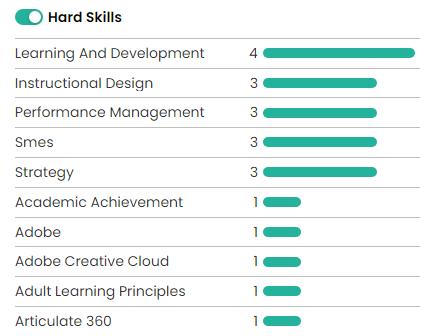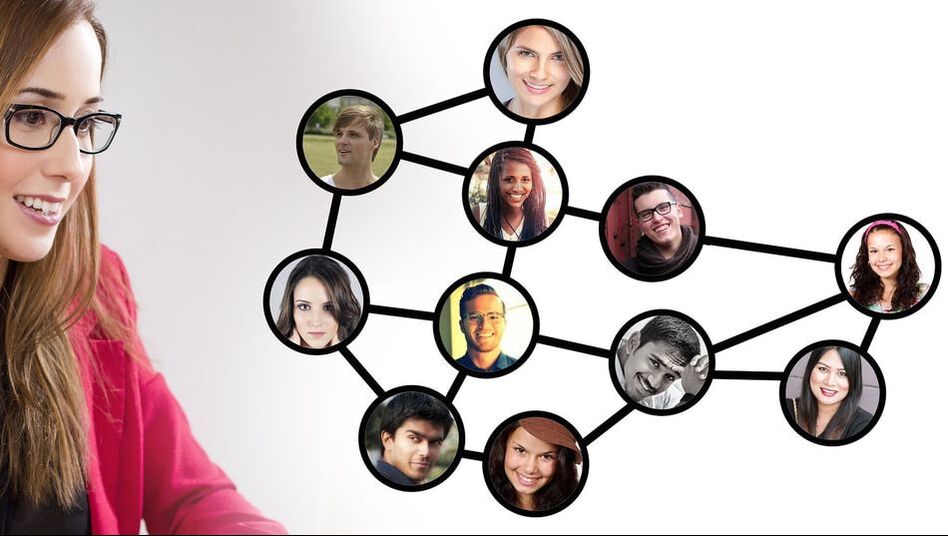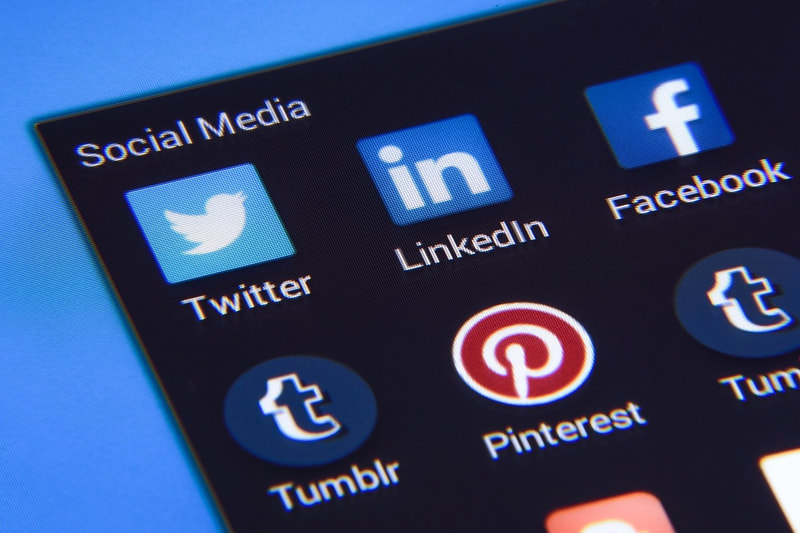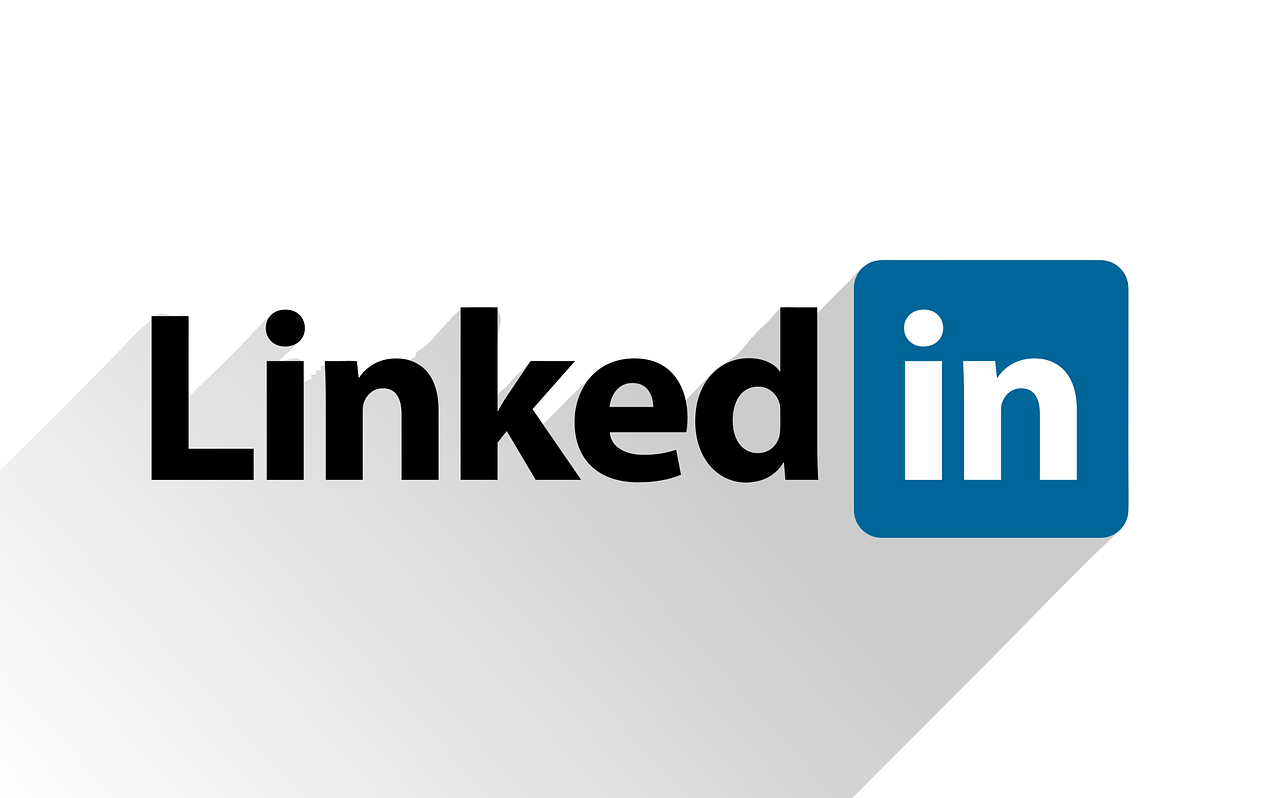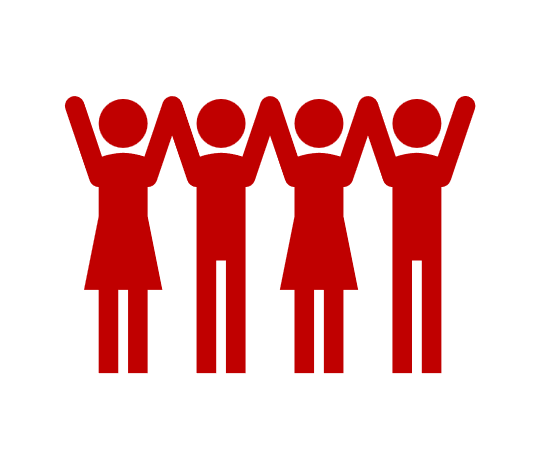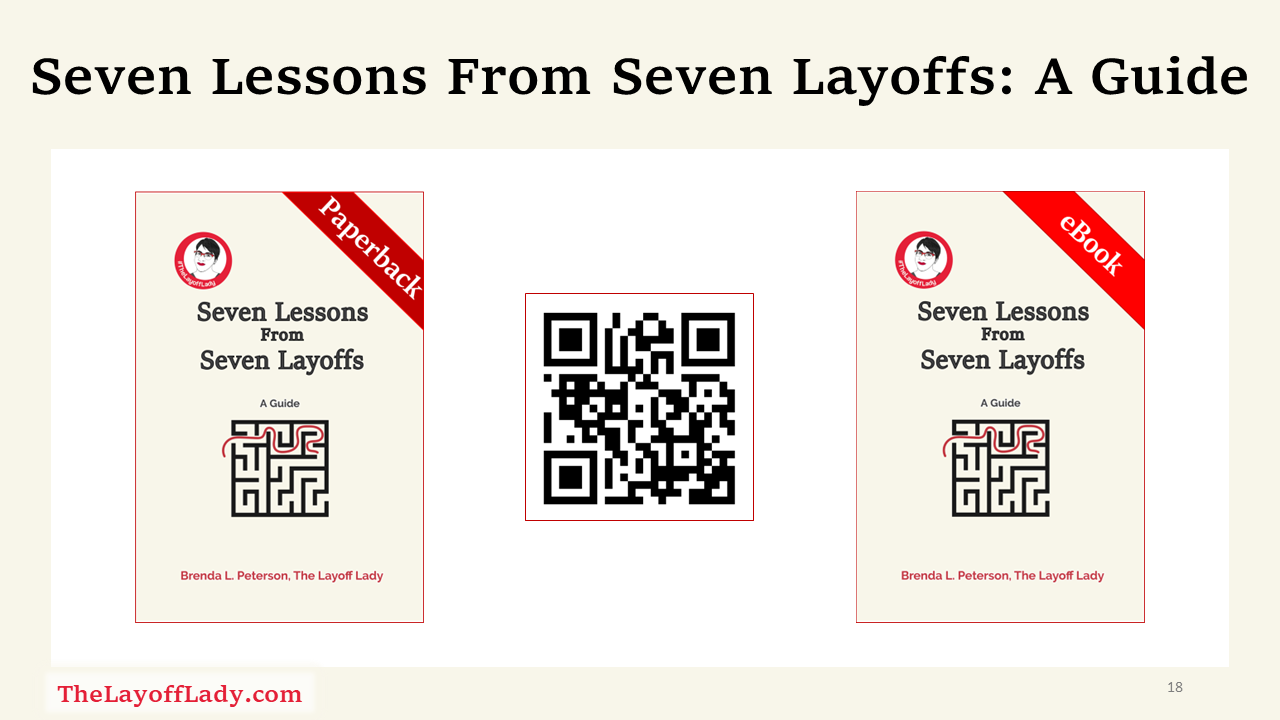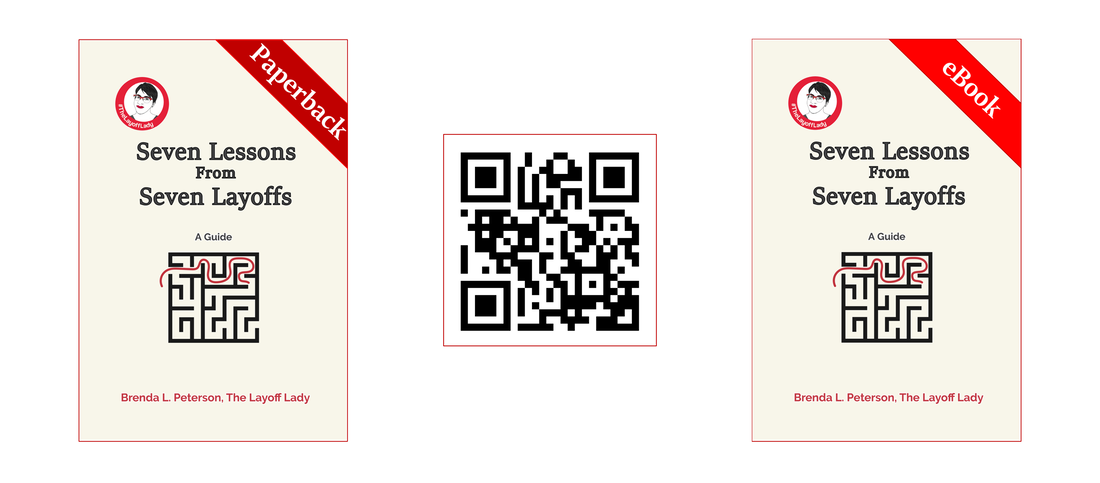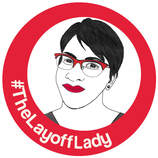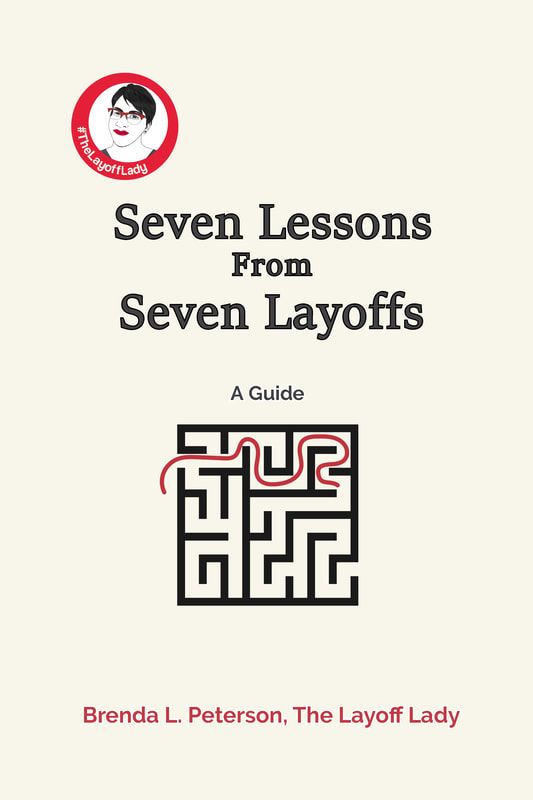|
by Brenda L. Peterson, The Layoff Lady Network Building in the BeforetimesPre-pandemic, "networking" typically meant attending in-person events, shaking a few hands, and having a somewhat meaningful conversation with another human. While in-person opportunities are again plentiful, webinars continue to be popular since they are a flexible way to bring people together to learn. Be sure to think of your network during virtual events, too. Connect with Webinar AttendeesLike many people, I have attended (and delivered) approximately a bijillion online meetings, trainings, and interactive instructor-led sessions. I've been approaching these sessions with a mind towards not just attending, but also making new connections. Although the process differs from in-person interaction with people, I have managed to connect with more people (and often form more meaningful connections) than attending in-person meetings and “working the room.” As someone who runs introverted and communicates effectively in writing, this was an opportunity to turn webinars into a bonus network-building exercise. Your Personal Webinar BrandingWhen attending a webinar, I make sure that people are able to see who I am, my full name, and a picture, if at all possible. I use the same photo I use on LinkedIn so that people associate me with that picture. I also make sure that my first and last name are present so people have a chance of being able to find me after the session--or will recognize my name. In addition, during the webinar, I interact during the session. This usually involves commenting in the chat when prompted--which is also an opportunity for other attendees to see my full name. During any small group interactions, I'm sure to turn my camera on so people can see my face, hear my voice, and see my name. If the presenter asks people to share out loud, I usually turn on my camera, and share my thoughts. Again, this is another opportunity for people to hear my voice, see my face, and see my name. Each of these "impressions" helps people start to get to know me at least a little bit. Finding Potential ConnectionsDuring a webinar, I often take a screenshot of the participant list and a gallery of attendees if people are on camera. Whenever possible, download the chat from the session. This helps me identify who was active in the webinar and gives me additional information on anything they might have shared during the session. I often make notes on notecards during sessions to help me remember who might have said what and key content covered. All of these details can help me when interacting with attendees later on when I send LinkedIn connection requests. Researching Potential ConnectionsAfter attending a webinar, here is my process for adding new LinkedIn connections:
One Option: Personalizing a Connection RequestPersonalizing connection requests is a great way to start building a relationship with a new professional contact. Here are the key components I include:
Personalized Connection Request ExamplesHere are a few examples of messages that you can use to invite people to connect. Currently, LinkedIn allows you to include up to 300 characters when personalizing connection requests. Hi, Jen. I see we both attended today’s White Box Club meeting. I’m also in career transition and seeking a new role in learning and development. Let's connect! I'm also always up for a 30-minute "virtual coffee" meeting to discuss how we can help one another as we job search. --Brenda Hi, Jack. Great to interact with you a bit at this morning's Excellence Share. I love sharing ideas with fellow L&D professionals. Let's connect! --Brenda Hi, Javier. I see we both attended today's "Sales Enablement Best Practices" webinar. I definitely enjoy learning from this group. Since you mentioned that you are job searching, be sure to check out The White Box Club on Meetup to help you as you find your next role. Let's connect! --Brenda Other Options: Showing Your Value as a ConnectionNow that LinkedIn limits the number of personalized connection requests those with the basic membership receive each month, sending personalized connection requests might not be an option for you. In those cases, here are a few other options for helping to show your value to a potential connection:
After The Initial ConnectionHow do you further nurture that relationship? Here are a few ideas.
Continue to Build The RelationshipAfter connecting with people initially, be sure to continue to nurture those connections. Posting useful content, and occasionally messaging people is one way to do that. Ideally, you can add value to the relationship before you are in a position where you need to ask those individuals for help. Learn More
0 Comments
By Brenda L. Peterson, The Layoff Lady So Many Openings!Depending on your chosen field, and your preferred work arrangements, there are a lot of jobs for which you could apply. While remote work availability gives each job applicant many more work options, figuring out how to prioritize open positions can be overwhelming. Here is my recommendation for evaluating open roles and prioritizing which job applications you submit. Searching for Available JobsIn this scenario, we'll look at how someone in a role as a Training Specialist can sort through a the sea of job listings and prioritize which openings should recive applications. To begin, I searched on Indeed.com for the job title Training Specialist. This search generated these results:
Without superpowers, it is not feasible to apply for 631 jobs in one week. Time to Apply and Available TimePersonally, when I decide to apply for a given role, I take about 30 minutes to research the company, customize my resume, and complete my formal application. In a given week, there are 7 days, which is 168 hours. There are not enough hours in a week for me to apply for that many jobs. Even if I somehow managed not to eat, sleep, or do even the most basic self-care, I could only apply for 336 jobs. Closer to the realm of feasibility, if I decided to dedicate a full 40 hours per week solely to applying for jobs, I could apply for 80 jobs—but definitely not well. In addition, working this long and this hard solely on submitting applications can put you on the fast track to burnout. Even half that, dedicating 20 hours solely to applying for jobs, and applying for 40 jobs in a given week, is most likely overkill. More Is Not Necessarily BetterThe more jobs I try to apply for in rapid succession, the less effective I am. While applying for jobs is in some respects, a numbers game, it’s not as easy as applying to all the jobs and knowing that one will work out. This strategy often causes people to waste time applying for roles that aren't a close enough fit. A better strategy is to prioritize jobs that are the best match for your skills and what you want and focus on applying for those well. When I'm in career transition, my goal is usually to apply for three jobs per week. However, if I see several great opportunities or have not searched for a job in a while, I may apply for as many as six. Beyond that, though, my application quality suffers. Prioritizing ApplicationsTo apply for jobs well, you need to determine the best way to prioritize your applications. Instead of the “spray and pray” approach, think through what you want and apply with more purpose. This approach favors quality over quantity and will help you focus your efforts on where you can get better overall results for your time investment. Step 1: Know Key Characteristics of What You WantEarly in your job search, it’s essential to do at least a little soul-searching and be able to articulate what you want. This may include revisiting your values, identifying your strengths, and thinking about the work you enjoy. For example, earlier career Brenda would have a list something like this on what she wanted from a role:
Having a stated list of preferences, and continuing to hone it as you learn more, is your first step in determining which jobs to target. Step 2: Narrowing Your SearchLet's go back to those 631 search results from my Training Specialist searches. By adding additional search parameters, we can narrow our results to jobs that more specifically meet our criteria: Starting with those 43 roles in Omaha:
Starting with those 588 remote jobs:
Step 3: Quick Job Listing ReviewNow that I have a more reasonable number of jobs to go through (12 and 45--57 total), I start to do a cursory review of the short descriptions of each role. No
Yes
I have now reduced the number of jobs that interest me to 31 roles. Step 4: More Detailed Job Listing ReviewNow that I have those 31 jobs in Teal, I look more closely at the following:
I remove jobs where I am not eligible. This includes the following:
I remove jobs with anything that might be a dealbreaker for me. This includes the following:
For the remaining jobs, I give them an initial rating of 1-5 stars and make notes on any areas I might want to explore further. I now have 18 jobs in Teal. Step 5: A Little More ResearchNext, I investigate a few things outside of the immediate job descriptions.
Now, I have 13 jobs In Teal. Step 6: Customize a Resume and Prepare to ApplyFrom the 13 jobs I have listed, I will apply for the jobs I'm most excited about and continue to reassess other openings listed. I will also add, remove, reprioritize, and take notes on specific roles as needed. Learn MoreBy Brenda L. Peterson, The Layoff Lady The Value of Professional NetworkingWhen it comes to job searching, professional networking is a critical component of success. Ideally, you make initial connections with people through LinkedIn (maybe even after meeting them in person or at an online group event). While this is a great start, there is value in building relationships beyond that initial connection. A 1:1 meeting can significantly strengthen a networking relationship and help you learn how you and your new connection can help one another succeed. About 1:1 Networking MeetingsSo what exactly is a networking meeting? Back in the day, I remember hearing people talk about doing "informational interviews." In short, if you were interested in having a particular job or working with a specific company, you would contact an organization or individual and ask if they would meet you for an informational interview. In this 1:1 meeting, which could take place via phone or in person, you might learn about the company, what they are looking for, skills to acquire, and more. It also allowed you to start to build a relationship with a company--or a possible advocate in the person doling out said information. Fast forward to now. Today, a networking meeting is typically between you and another person deciding to spend a half hour-ish together. This meeting, sometimes called a coffee chat, could happen virtually via Zoom or in person, often over coffee. If you're job searching, the typical focus will be on how to progress in your job search. Someone may agree to a networking meeting because you have things in common (like a field of work, background, professional goals), because they are generally committed to helping people when they are job searching, or because you have a mutual acquaintance to ask that person to meet with you to help you out. Networking Meeting = Informal InterviewWhenever you have an opportunity to meet one-on-one with someone, remember that you are taking part in a type of informal interview. Whenever I meet with someone in career transition, my goal is to help them figure out their next steps, offer advice (if they ask and are interested), and give them ideas on further steps they might take, including who they should speak with next While I go in with this idea, the amount of help I'll provide also depends on how this networking meeting goes. Ideally, we have a good, productive conversation, and I think to myself, "I totally want to help this person more." If the meeting goes well, I'll refer them to specific resources that might benefit them (like a networking group they might want to join, a company to check out, someone to follow on LinkedIn) and even put in a good word for them to have a networking meeting with someone else who might get them closer to their goals. In addition, if it goes REALLY well, this is a person who I'll refer to others for openings, pass on job opportunities, and maybe even hire someday. If the meeting doesn't go well, I'll share a few resources, but I may not be willing to help them as actively moving forward. Remember, any interaction you have with people will impact their desire to help you in the future. Types of Networking MeetingsHere are a few common types of networking meetings:
Networking Meeting Best PracticesHere are a few best practices for networking meetings:
The True Power of Networking MeetingsWhen people talk about how they "networked" into a new job, typically, that means they leveraged their initial connections to help make inroads with new contacts, who helped them get closer to a new position. The holy grail of networking meetings is when the person you meet with agrees to introduce you to someone else they know who could help you. That process repeats until you're talking to a hiring manager or influencer who can help you get an interview for a job. Having good networking meetings is a critical step in that process. Learn MoreBy Brenda L. Peterson, The Layoff Lady Getting To Know Your LinkedIn ConnectionsConnecting with someone on LinkedIn is a great way to start a formalized relationship with someone in your professional network. While that is a great start, deepening those relationships is a helpful next step to get more value out of LinkedIn. Let's look at a few ways to do just that. Interacting with PostsInteracting with posts on LinkedIn is a great way to continue to build relationships with your connections and demonstrate your professional value. Not only is this a great way to build your credibility with many connections at the same time, it also gives you an opportunity to showcase your knowledge without having to choose the initial content for the post. You can also use your comments to interact with others and even use this as a starting point to invite other commenters to connect. Adding Your ReactionThe easiest way to interact is by adding a reaction to a post. With a click of a button, you can like a post or select from the other available responses. When you react to a post, your name will be listed on the post as well. This is an easy way to have people see your name and affiliate it with the content you liked. Adding your reaction also helps more people see the original post. Commenting on a PostAn even more valuable way to interact with a post is by commenting. Once you have connected with someone, reading and commenting on their posts is an excellent way to build on that relationship. This way, they are starting the conversation, and you are helping expand on that content by adding your ideas. In addition, you can comment on other people's comments and share additional value. You can thank the initial poster for sharing the idea, add your thoughts, share your experiences, and illustrate how you have used the concept in practice. Commenting on posts also gives you an inroad to connect with someone else who is also interacting with that post. Commenting is a great way to interact with others in your profession, build credibility, and make more meaningful connections. It also helps to achieve one of your LinkedIn goals of showcasing your knowledge and also sharing valuable information. RepostingIf someone posts something of value to your connections, you may want to comment on the post itself and then consider reposting it with your comments. When you repost content, first, you'll see anything you typed, then LinkedIn will include the entire original post. This helps the original post get additional views and also enables you to share useful content with your network. When I repost content, I usually include "Thanks [original poster] for sharing this information!" To include the original poster's name, include the @, then type the first part of their name, and choose their name from the options provided. (This is often called an "at mention." This will tag them in the post so they can interact with your new post, which will help boost the number of people who see the post. Sharing Your Own LinkedIn PostsSharing content on LinkedIn is a great way to engage with your connections, add value to your professional relationships, and promote who you are and what you know. Unfortunately, very few people ever post anything at all--which is a huge missed opportunity to differentiate yourself from others in your field. Another question that comes up is the frequency of posting. I recommend posting on LinkedIn no more than once a day and posting one to four times per week. Use your favorite search engine for recommendations on the best times and days of the week to post to get the most views on your posts. As for content, you don't have to write a lengthy, original manifesto to post on LinkedIn and make an impact. Personally, most of the content I share on LinkedIn includes some version of the following:
Once you make a post, be sure to like any comments other people make on your post and even reply to each comment. The more likes and comments you receive on your post, the more people will see it. This will continue to build your professional brand and add value to the networking relationships you are fostering through LinkedIn. Learn More
By Brenda L. Peterson, The Layoff Lady About Personal BrandingWhether you're actively job searching or just trying to build your professional network, sharing content on social media is a great way to demonstrate your value. By identifying topics that people with your professional focus care about and sharing related content, you will help people associate your name with those areas of expertise. While regularly sharing content is valuable, it can also be time-consuming. Here are three tools I regularly use to organize and streamline this process. Google AlertsOn LinkedIn, you will share some content that you directly create. This might include a post about an event you attended, your career news, or your observations on a given topic. When it comes to LinkedIn, most of my content includes articles on critical topics of interest, with some introductory commentary framing the value I see in the article. This means I need to locate and collect those articles to post them as needed. One way I locate helpful content on each topic is to set up a Google Alert for keywords or phrases relevant to my professional skill set. Each Google Alert sends you an email with new online content regularly. Here are a few examples of what Google Alerts you may want to set up:
After you identify the keywords for topics that people in your industry talk about, create alerts to keep a steady stream of content coming to you. Flipboard serves two essential purposes. First, you can follow exciting topics and see content other users share. Second, you can use Flipboard to create magazines on a given subject area and bookmark content that interests you for later use. Here are a few ways you might find content to save in a Flipboard magazine:
Gathering possible information to post when you run across it, organizing it, and making it easy to access will save you a lot of time figuring out what to post. BufferWhile the other two tools are about finding and organizing possible content to post, now let's look at a tool to schedule those posts. There are several tools available to help you manage social media posts. Currently, I use Buffer. This online platform has a free version that will enable you to manage posting on up to three social media platforms. When my goal is building my professional network and job searching, I focus on LinkedIn. Buffer enables you to create, schedule, and update posts as needed. When searching for a new role, I may post as often as daily. When focusing on building or maintaining my network, I may post once or twice a week. The Learn More section includes recommendations on how often and at what times you may want to share content for the greatest impact. Creating A Post When I create a post to share an article, I often include the following details:
Here are a few examples:
Learn MoreBy Brenda L. Peterson, The Layoff Lady Messaging With Your ConnectionsOne of the benefits of having connections on LinkedIn is that you can directly send them messages without having a paid subscription. However, this feature has also been used poorly on several occasions. Let's look at how to use LinkedIn messaging effectively to continue building professional relationships and provide some guidelines for how to use this feature well. The Value of Mutually Beneficial RelationshipsTo have a valuable professional newtork, make sure those relationships are mutually beneficial. Networking is about give and take. Make sure that you are adding value along the way. This includes sharing useful content, congratulating people on their accomplishments, and answering one-off questions when people ask for advice. In short, be a good LinkedIn neighbor. If you give more than you take, your LinkedIn connections will be more likely to help you when you need it. Messages That Add ValueWhen directly contacting your LinkedIn connections, make sure you are not overfocused on asking for favors. It is important to provide value first. Here are a few types of messages that give more than they take:
Make sure you are not THAT PERSON who only reaches out when they need a favor. Direct Asks For Help: Worst PracticesAsking for help is an art. First, you need to be willing to ask for help. Next, you need to craft your ask in a way that you have a higher likelihood of getting that help. Here are a few significant issues I’ve seen from people attempting to ask for job search help:
The Worst AsksHere are a three questions that may not get you much of a response:
Why are these not good asks? For one, these are big requests that require a lot of effort to do well. For example:
Direct Asks For Help: Better PracticesHere are a few better asks, but may only work with connections who you know very well and who you have helped in the past:
These requests are specific, which is better, but each is still a sizeable request. The first two may be time intensive. The next two involve your connection putting their reputation on the line to recommend you for a role. The final one requires a block of time on your connection's calendar. Depending on our interactions prior to these requests, their response may vary from “of course!” to no response at all. Again, remember to make sure your asks are aligned with how well you know one another. Direct Asks for Help: Best PracticesAsks are better when they are more specific and less time intensive. It’s also helpful if there is context. Here are a few asks that are more likely to get responses. The requests earlier in this list are more likely to get a response.
People Get To Say NoRemember, when you are asking for help, people will tell you no. More likely than telling you a direct no, they may just not respond. Ever. Keep in mind that job searching, like sales, means that you're going to hear a whole lot of no on the way to that one yes you need. When you need a specific thing, it's useful to ask multiple people for help to give you a better chance of getting a response. It's also not personal. We're each on LinkedIn using it to varying degrees and all trying to accomplish our own goals. Making sure that you are making the relationships mutually beneficial will make it much more likely that people will respond to you and want to lend you a hand when you need it. Learn More
By Brenda L. Peterson, The Layoff Lady Preparing for a Positive ScenarioContingency planning is not the most upbeat topic. It's all about making a backup plan just in case something terrible happens. Instead of predicting doom and gloom, let's update our planning approach and focus on opportunity readiness. Opportunity readiness is about thinking about who you truly are, what you want your work life to be, and living into that future. When you step into that role of being the CEO of you, your focus shifts to what you want to be and positioning yourself for that success. If you've done that, you'll be able to identify what an amazing opportunity is for you--and be ready to go for it! An Opportunity Presents ItselfEven when you like your current company, position, or coworkers, sometimes you might hear about an opportunity that could be the right next step for you in your career. Here's what that might look like:
In each of these cases, you weren't actively looking for a new role. However, once you heard about the opening, you realized it might be just the thing you were looking for and found out more! Opportunity ReadinessOpportunity readiness is a part of career resilience that may not always occur to us. When people are not actively job searching, sometimes they neglect to make new networking connections, keep in touch with people they know, update their LinkedIn, or update their resume. However, these are EXACTLY the things to prioritize. Knowing what you want, staying in touch with your network, and always evolving your skills will position you to move quickly when the time comes. Your ResumeYour resume is the main document potential employers want to see. Even if someone contacts you about an opening, you’ll need an up-to-date resume to be considered. This document needs to summarize who you are as a candidate as well as your most relevant skills, work history, education, professional affiliations, and accomplishments. This is where you can shine! Keeping your resume current is a crucial first step. Including details on your current role, adding newly earned credentials, and highlighting recently used skills can help you shine. Getting a resume out the door within a couple of hours can improve your chances of being seriously considered. It's also a great way to help the person who connected you with the opportunity feel even more sure that you're a great fit! Your LinkedIn ProfileLinkedIn is your professional billboard to the working world. It is an all-purpose marketing tool where people can view information beyond your resume, see which other people and companies you may have in common, and read the content you share in your posts. When people are gainfully employed, they often stop fine-tuning their profiles and interacting with their professional connections. Taking time to polish your LinkedIn profile and posting content on your areas of expertise is a way to remind people of you and your professional value. In fact, continuing to be active on LinkedIn may very well be why someone contacts you about what might be the perfect opportunity for you. A great way to remind people of who you are and what you're good at is by posting relevant content. Sharing a picture of you leading a training session, or an article about a great new way to optimize a project will help people associate you even further with your skillset. Your Work SamplesYour work samples, often called your portfolio, are a way to demonstrate the skills you mention in your resume or LinkedIn profile. These work samples should give the hiring team an idea of your process and finished product examples. Creating a portfolio is not something that most people can quickly throw together. There are several steps, including identifying your overall portfolio goals, developing or selecting work samples, positioning each work sample to showcase your professional capabilities, and determining the technological aspects of how you might set up your portfolio. Since some employers may require a portfolio before seriously considering you for a role, pulling this together and updating it as needed can help make you success-ready. As you complete interesting projects,remember to add those to your portfolio It' s nice to have your portfolio grow and change as you evolve your skills. What Do You Think?What do you think would prepare you to move quickly on an opportunity if one presented itself? Include your thoughts in the comments. Learn More
By Brenda L. Peterson, The Layoff Lady The Challenge: Describing What You DoWhether you're searching for a new role or thinking about your professional development, not having the right words to describe your skillset can hinder your progress. Identifying your career keywords will help you create effective messaging for your LinkedIn profile, resume, conversations with colleagues, and other written communications like email and social media posts. Where To Start: LinkedIn and KeywordsHere is my recommendation for how to begin gathering keywords that align with your chosen profession:
Let me take you through an example. Search for Your Target Job TitleI searched LinkedIn's Jobs section for Business Partner Organizational Development in the United States. From the results, I selected ten currently open positions to review further (because I'm an overachiever like that). Here are those job titles:
Lesson Learned: When you search for a job title, your results will include a variety of titles different companies use. Be sure to review the job description to learn more about what that company expects from that role. The duties for the same job title might vary widely from company to company, as might the terminology they use to describe it. Identifying Skills and KeywordsTotal Number of Different Skills Returned for All Ten Jobs For the 10 jobs I reviewed, 69 different skills were included in the results. For context, if all roles had the exact same skills, this number would be 10. If all of the roles had different skills, this number would be 100. Lesson Learned: Not only will job titles vary across organizations, but what skills they value can also differ. Be sure to review the job description to learn more about what skills the company thinks will help make someone in that role successful. Specific Skills Returned For More Than One Job Several skills came up more than once across those ten jobs. Here is the number of times a specific skill appeared for more than one role:
Lesson Learned: Even if there is not widespread agreement on the terminology used across organizations, some keywords will show up more often. Consider including popular keywords in your skills section on your LinkedIn profile and in your resume. Different Keywords for Similar Skills While specific keywords like "communication" and "problem solving" appeared more than once within the 10 job descriptions, several related terms might be included instead. Here are a few groups of terms that take different approaches to describing similar concepts:
Lesson Learned: When you look at the groupings of keywords, you can see the broader areas where roles like this would operate. Each company may use slightly different terminology regarding the skills that they value. When you talk about the work you do, consider weaving some of these words into your stories. What Do You Think?How do you identify the right keywords to use to describe what you do? Share your thoughts in the comments. Learn More
By Brenda L. Peterson, The Layoff Lady About The Seven Layoff LessonsThrough my seven layoffs and many conversations with others in post-layoff career transition, I have learned seven core lessons:
About Layoff Lesson Five: Help People Help YouLife is challenging when nothing out-of-the-ordinary is happening. It's even harder when you're going through an unexpected job change. While I'm a fan of self-reliance, I also know how important it is to find your people and support one another as you go through challenges. You're not weak for needing people. You are strong because you know the value of building and leveraging relationships to help get you through trying times. I have found that people genuinely want to help. In many cases, though, they might not know what you need. Not only is it vital that you seek out help when you need it, but you need to figure out what type of help you need. One Career Transition RevelationHere's something that might surprise you. When you tell people that you're looking for a new job, this is when you will discover that many people don’t know exactly what it is you do for a living. Instead of being taken aback that they don’t know, use this as an opportunity to learn how to tell them what you want and need during your career transition--and it's much more than just a new paying job. Figure Out What Life Help You NeedFirst off, you need to figure the types of life help you might need:
Figure Out What Job Search Help You NeedIn addition, you need to figure the types of job search help you might need:
It Takes a VillageOnce you have a better idea of what you need, make sure you don't expect one person to fill all of these roles. Think about who could help you in each area and reach out to them. Leveraging Your Professional NetworkLinkedIn is my goto tool for building and managing my professional network. It's importan to make sure your LinkedIn profile represents you well, and that you showcase your experience and the value you bring to others, and to a new role. There is also an art (and a process) to asking people in your professional network in a way that is mutually beneficial. For The Whole StoryFor all the information on each of the seven lessons pick up a copy of my book Seven Lessons From Seven Layoffs: A Guide. Learn MoreBy Brenda L. Peterson, The Layoff Lady About The Seven Layoff LessonsThrough my seven layoffs and many conversations with others in post-layoff career transition, I have learned seven core lessons:
About Layoff Lesson Four: Shape and Share Your StoryNow that you’ve determined what you want in your next role, your new challenge is learning to tell your story. This includes telling the overall story of who you are professionally and the value you bring. To this end, you'll use a few key documents to summarize what you do, highlight your core accomplishments, and persuade that employer that they should spend more time learning about you. Your Job Search ToolkitYour job search toolkit is the collection of information you need to showcase your value to a potential employer. Each item in this list helps you share a part of your story during the hiring process.
Your What I Want StatementBased on what you learned during your Structured Soul Searching, the next step is writing a clear and concise “What I Want Statement." This statement can help you as you review job openings and prioritize your applications to those that most closely align with your goals. This statement can also be repurposed when letting other people know what jobs interest you the most. Your Professional SummaryIn addition to your “What I Want” statement, you also need to be able to tell your career story. Your professional summary is that paragraph of quick-hit information that starts to outline who you are, your qualifications, and what you bring to the table as a candidate. This statement can also be repurposed when letting other people know what jobs interest you the most. Your Interview AnswersThe same stories you use in your resume to showcase your skills and the results they generate can also become the answer to commonly asked interview questions. Instead of answering with no plan and hoping for the best, you can use a model, like CARL or STAR, to structure your answers and get to your point more quickly. For The Whole StoryFor all the information on each of the seven lessons pick up a copy of my book Seven Lessons From Seven Layoffs: A Guide. Learn More |

Just get laid off?
Click here for info on what to do first. Author7-time layoff survivor Brenda L. Peterson, The Layoff Lady, waxes poetic on layoffs, job transitions, & career resilience. Buy The Book!Were you recently laid off from your job and need a roadmap for what's next? Pick up a copy of my book, Seven Lessons From Seven Layoffs: A Guide!
Categories
All
Archives
July 2024
|




